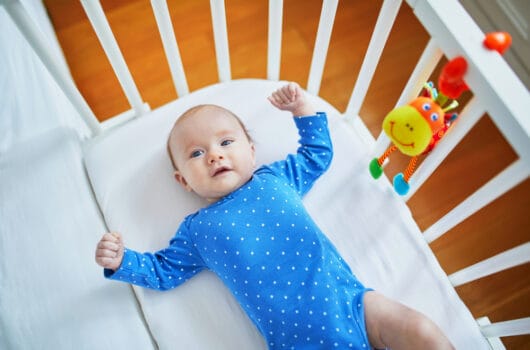What if we told you there was a way to get more sleep at night, even with a newborn? You’d say, “Sign me up,” right? Best of all, this isn’t some magic solution. To get more sleep at night, you need to keep your baby in the room with you. Keeping your baby close by is safer and convenient—especially if you’re breastfeeding. You’ll want your baby as close as possible for all those night-wakings!
This sounds great, we know, but is it safe?
It can be! The best way to keep your baby close to you at night safely is to use a co-sleeper. Like anything else baby-related, though, there are many different types and options. How do you know which is best?
No worries—we’re here to help! We’ll highlight the important aspects of co-sleepers as well as share our reviews of the best baby co-sleepers on the market. We’ll also answer all your questions on co-sleeping so you can make the best choice for your little one.
- Important Aspects of Baby Co-Sleepers
- Top 10 Best Baby Co-Sleepers 2025
- 1. Best Overall Baby Co-Sleeper: SwaddleMe By Your Side Sleeper
- 2. Best Baby Co-Sleeper for Bigger Babies: Mika Micky Bedside Sleeper
- 3. Best Organic Baby Co-Sleeper: Snuggle Me Organic Lounger
- 4. Most Womb-Like Baby Co-Sleeper: DockATot Deluxe+ Dock Lounger
- 5. Best Bedside Baby Co-Sleeper for Tall Beds: Milliard Side Sleeper Bedside Bassinet
- 6. Best Budget Baby Co-Sleeper: Baby Delight Snuggle Nest
- 7. Best Baby Co-Sleeper for Outdoor Naps: Lulyboo Bassinet To-Go Infant Travel Bed
- 8. Widest Baby Co-Sleeper: Mamibaby Baby Lounger
- 9. Best Space-Saving Baby Co-Sleeper: Simmons Kids By the Bed City Sleeper
- 10. Best Premium Baby Co-Sleeper: Baby Delight Beside Me Dreamer Bassinet & Bedside Sleeper
- Complete Guide to Buying the Best Baby Co-Sleepers for 2025
- Final Thoughts on Co-Sleeping
Important Aspects of Baby Co-Sleepers
When choosing the right baby co-sleeper for you, you’ll want to keep these important factors in mind.
Type
There are several different types of baby co-sleepers and which one you choose depends on personal preference as well as how much room you have. This is just a brief overview, but if you’re looking for a comprehensive guide to which co-sleeper is best for you, then be sure to read our Guide to Buying the Best Baby Co-Sleepers below.
In-Bed Bassinet
Want to snuggle with your baby all night? In-bed bassinets allow you to do so safely. They’re made to be placed on top of your bed so you can have your baby right next to you at night. They typically have rigid sides to keep your baby safe from you or your partner rolling over accidentally. These beds are great for keeping your baby close for nighttime feeds and allowing your baby to hear you and sense you nearby. You can read more about in-bed bassinets in our Complete Guide to Buying the Best Baby Co-Sleepers below.
Bedside Bassinet
If you’re concerned the most about safety—and what parent isn’t? —then a bedside bassinet is the best option. It combines the best of co-sleeping and having your baby in their own sleeping space. Your baby is close enough for you to reach over and pull them into your bed for nightly feeds, but your baby will also have their own space.
If you’re looking for a quick comparison of the different measurements of the bedside co-sleepers on our list, including the maximum bed height and lowest bed height measurements, then go to the Bedside Bassinet heading below.
Lounger
Loungers have plush sides that hug in around your baby while they sleep on their back in the middle. The lounger co-sleepers are soft, plush, and designed to make your baby feel like you’re still holding him/her in your arms. Newborns generally don’t like to be put down, so the way the lounger mimics the snugness of the womb helps them sleep better. Always a plus for tired parents!
However, loungers can become a safety concern once your baby can roll over because they can get themselves in a position where their face is against the soft sides. In fact, the American Academy of Pediatrics (AAP) labels baby loungers unsafe for sleep. They’re still popular as co-sleepers, so we wanted to include them on our list, but you need to be aware that the safest way to use this type of bed is while at least one parent is awake.
Safety
Safety becomes your number one concern from the moment that sweet, helpless baby is placed in your arms. It makes sense that the bed you choose to put your baby in is safe, too.
There are many ways that baby co-sleepers are designed to be safe—at least until your baby starts rolling. You want it to have things like:
- Mesh sides so your baby has plenty of airflow
- Firm, flat sleeping surface to keep your baby safe from smothering
- No loose sheets, blankets, or other soft material that could end up preventing your baby from breathing properly
- Sturdy construction to prevent collapsing
- Safety straps to keep it firmly attached to your bed
Functionality and Versatility
Baby products can be expensive, so it helps if an item can serve multiple purposes. After all, you want your dollar to stretch as far as it possibly can!
Some of the beds have functions other than just being a comfortable place for your baby to sleep. This way you get more use out of it. It’s also ideal if the bed makes your life easier in some way, like being lightweight or adjustable.
We looked for beds that had functions like:
- Providing a safe place to put your baby down while you do other things
- Having extra storage for diapers and other supplies
- The ability to transform to a stand-alone bassinet
- Foldable so you can easily travel with it or store it
- Being mobile and lightweight so you can move it around easily
- Adjustable height so it can be the same level as your bed
Size
If you’re tight on space, you probably don’t want some giant, hulking bassinet taking up all the room. We’ve noted in our reviews which co-sleepers are compact and which are on the bigger side. It’s also important to consider your bed size if you plan to buy a lounger or an in-bed bassinet. Most of the time, you and your partner will be most comfortable if you have a king-size bed to share with your baby’s bassinet or lounger.
If you’re wondering what the different measurements are for the common bed sizes, we have you covered below under the In-Bed Bassinet heading.
Now that you know which aspects are important for baby co-sleepers, let’s look at the reviews for our favorites.
Top 10 Best Baby Co-Sleepers 2025
1. Best Overall Baby Co-Sleeper: SwaddleMe By Your Side Sleeper
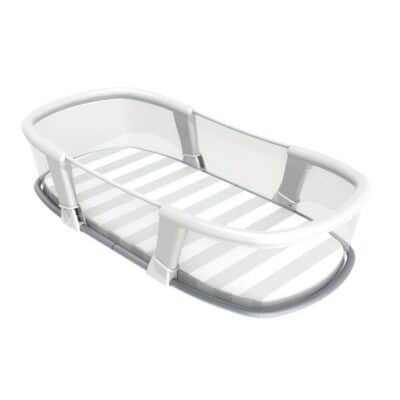
Editor’s Rating:
Quick Facts:
- Type: In-Bed Bassinet
- Functionality: Foldable
- Size: 32 Inches Long x 15 ½ Inches Wide x 11 Inches High
If you’re looking for an in-bed co-sleeper that has some great safety features and isn’t high-priced, then the SwaddleMe By Your Side Sleeper is the way to go. Many co-sleepers don’t include a mattress pad or fitted sheet, but the SwaddleMe includes both. Regular bassinet sheets fit it perfectly, and we recommend having extra sheets for those inevitable accidents (which always seem to happen in the middle of the night).
Safety
The sturdy metal frame will keep your baby safe from a parent accidentally rolling over in bed. What we really like about it, though, is the mesh sides. For one thing, it makes it easier to see your baby while you’re lying down. If you haven’t realized it already, a large part of parenthood is getting as much rest as you can, and if that means not lifting your head off the pillow, then so be it!
The mesh is also safer for your baby in the event they somehow get their face up against the side of the co-sleeper. This way, your baby will still be able to breathe.
Functionality & Versatility
The SwaddleMe co-sleeper is foldable, so it’s easy to take with you when you travel. Aside from that, though, it doesn’t do much else. You can pay a little more and get the deluxe version, which includes an attachment that plays soothing sounds, has a nightlight, and vibrates.
Size
While it’s a comfortable size for your baby, this co-sleeper takes up a lot of room in your bed. If you have a queen-sized bed and your partner will be sleeping with you, too, then it’s an uncomfortably tight fit. It’s probably best suited for a king-sized bed if you’d both prefer to be able to move your arms and legs.
Your baby is also likely to outgrow this co-sleeper quickly, which isn’t uncommon for in-bed bassinet types. Once your baby starts to roll or push themselves up on their hands and knees, then they’ll need to move to a crib for safety. Plan on only using this co-sleeper for the first three months or so.
Verdict
Because your baby will outgrow the SwaddleMe Sleeper quickly, it’s helpful that it’s one of the least expensive options. With the mesh sides and metal frame, you can feel pretty confident that your baby won’t be smothered in the night or be squished by a parent accidentally rolling over. If you have a queen-sized bed or smaller, though, you should look at slimmer options like the Baby Delight Snuggle Nest.
Pros
- Sturdy metal frame
- Mesh sides
- Mattress and fitted sheet are included
- Folds for travel
- One of the more inexpensive co-sleepers
Cons
- It takes up a lot of room in your bed, so it might be best for king-sized beds only
2. Best Baby Co-Sleeper for Bigger Babies: Mika Micky Bedside Sleeper

Editor’s Rating:
Quick Facts:
- Type: Bedside Bassinet
- Functionality: Wheels With Brakes, Two Storage Pockets
- Size: 32 Inches Long x 15 ½ Inches Wide x 11 Inches High
Most co-sleepers have a low weight limit—around 20 pounds—but the Mika Micky Bedside Sleeper can hold babies up to 33 pounds! This makes it a longer-lasting purchase than most other co-sleepers.
Safety
Although it doesn’t have sides completely made of mesh all the way around like the SwaddleMe Sleeper or the Baby Delight Beside Me Bassinet, the Mika Micky Sleeper has mesh on the two longest sides of the bassinet.
It also has straps to anchor to your bed and keep it from moving. The wheels lock in place so you don’t have to worry about the co-sleeper rolling away if it gets bumped accidentally.
Functionality & Versatility
The co-sleeper doesn’t require any tools to assemble, but the instructions are confusing and largely unhelpful. We recommend watching the video tutorial on the product link above. It also folds down flat for travel, but again, watch the video tutorial rather than trying to decipher the instructions.
We like the wheels on the feet of the co-sleeper because they allow you to easily move it around without having to pick it up. It converts to a stand-alone bassinet, so having wheels to move it is convenient.
It also has two storage pockets, but they aren’t very big. They can hold a few diapers and a slim pack of wipes, but that’s still handy for middle-of-the-night changes.
Size
The max height of this co-sleeper (from where the baby sleeps in the bed) is 28 inches. Since the majority of parent beds are 25 inches high, this will fit beside most beds. It has seven different height adjustments, and it can fit beds as low as 18 inches. If you’re looking for a bedside co-sleeper that will fit an even lower bed, the Baby Delight Beside Me Bassinet is ideal for low beds. For beds higher than 28 inches, the Milliard Side Sleeper will work with beds up to 31 inches.
This co-sleeper is definitely for bedrooms with a lot of space as it’s 24.5 inches wide. This extra space, though, is what makes it perfect for bigger babies. The recommendations on this co-sleeper are that it can sleep babies up to 33 pounds, or until your baby can sit up. That means your baby could potentially sleep in this bedside bassinet until 5 or 6 months of age—possibly longer, depending on your baby’s size and ability.
Verdict
If you want to use a bedside co-sleeper for longer, then the Mika Micky Sleeper is a great choice. You’ll likely get a month or two more of use out of this co-sleeper than other models. It can be a pain to assemble though, so be sure to watch the video on it.
Pros
- Large enough for bigger, older babies
- 7 different height adjustment levels
- Folds flat for travel
- Mesh on two sides
Cons
- Assembly is complicated
- Takes up a lot of space in your room
3. Best Organic Baby Co-Sleeper: Snuggle Me Organic Lounger
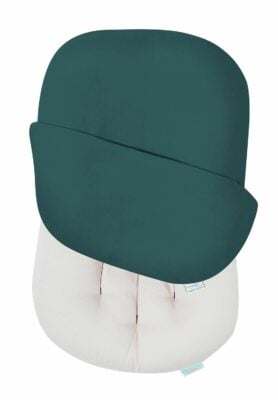
Editor’s Rating:
Quick Facts:
- Type: Lounger
- Functionality: Washable, Portable
- Size: 29 Inches Long x 18 Inches Wide x 4 Inches High
One of the advantages of a co-sleeper is that they’re usually portable enough that your baby can sleep in them wherever you are. This is especially true of the Snuggle Me Organic Lounger because it’s lightweight, and its plush sides hug in around your baby to make them think they’re still in your arms.
The Snuggle Me and the DockATot are frequently compared, but the Snuggle Me wins out on how much it snugs in around your baby. Because of the sling design in the center, the thick sides hug in around even tiny newborns. The DockATot leaves more room around your baby.
Safety
The sides of the lounger are high enough that your baby can’t roll out, but they’re also low enough that they don’t pose as much of a suffocation risk. However, the American Academy of Pediatrics (AAP) isn’t a fan of using loungers for sleep at night. You can read more about the safety guidelines for co-sleepers under the Are Co-Sleepers Safe for Babies? heading.
Loungers are recommended for supervised sleep and play only. If you work from home, these can be a lifesaver because your baby can sleep right next to you in their comfy lounger while you type hands-free.
Functionality & Versatility
The Snuggle Me Lounger comes with an organic, washable cover that’s incredibly soft and makes it easy to deal with those inevitable diaper leaks because you can just pull it off and throw it in the wash. The covers come in a variety of colors, so you can match it to your nursery decor for the ultimate in baby aesthetics.
The lounger is also washable and made in the USA to be completely non-toxic and free of harmful chemicals. Babies spend a lot of time sleeping (must be nice!), so you want anything they lie on to be as chemical-free as possible.
Let’s be real, though. This is essentially an expensive baby pillow. However, it does have a variety of uses. You can use it for supervised nap time to leave you hands-free, as a comfy place for tummy time, or even to just lounge beside you while you have your morning coffee.
Size
If you do put this lounger in the bed with you (supervised, of course) just know that it’s a huge bed hog. At 18 inches wide, it’ll take up a lot of room on any parent bed, but especially a full or queen.
It’s also not as long as most other co-sleepers, so your baby will outgrow it quickly. However, just because your baby gets too long for the sling in the middle doesn’t mean they can’t continue to use it when they’re older. They’ll just drape their legs over the bottom.
Verdict
The Snuggle Me Lounger gives you a comfy place to put your baby instead of having to hold them all the time. It’s easy to wash and extremely portable, so you can bring your baby’s favorite bed with them wherever you go. If you decide to use it in bed with you, though, just know that the AAP doesn’t recommend using loungers for co-sleeping.
Pros
- Soft, organic fabric
- Washable organic covers in different colors
- Light and portable
- Mimics holding your baby in your arms
Cons
- AAP doesn’t recommend loungers for co-sleeping
- Basically an expensive baby pillow
4. Most Womb-Like Baby Co-Sleeper: DockATot Deluxe+ Dock Lounger
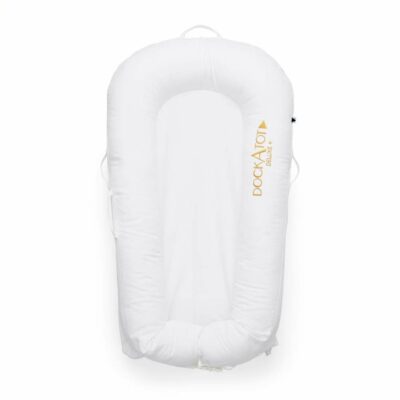
Editor’s Rating:
Quick Facts:
- Type: Lounger
- Functionality: Washable, Portable
- Size: 24 Inches Long x 18 Inches Wide x 6 Inches High
If you’re looking for a baby lounger with lots of Instagram-worthy designs and color choices, then the DockATot Deluxe+ is the one for you. Like the Snuggle Me Lounger, the DockATot has plush sides that snuggle in around your baby, creating a womb-like feeling of being held. However, the fabrics are not as soft as the Snuggle Me Lounger’s, and they aren’t organic.
Safety
Even though the manufacturer of DockATot has this lounger listed as perfect for co-sleeping, the AAP doesn’t recommend it. If you do use it in your bed, the sides are higher than the Snuggle Me Lounger to protect your baby from a parent accidentally rolling over onto the bed.
Tiny newborns will likely have a little more space all the way around and not be snuggled as closely as they are in the Snuggle Me Lounger. Newborns tend to not be able to move around much, but if they are ever able to turn themselves toward one of the sides, it could become a suffocation risk.
Functionality & Versatility
The DockATot is very light and portable, so you can easily bring it along with your baby. It’s great for tummy time, naps, and even a safe place to lay your baby while you do some hands-free work. You can also buy an arch to fit over your DockATot to hang toys from. This converts the DockATot into a comfy baby gym. For an even more expensive baby pillow than the Snuggle Me Lounger, it’s good that it’s at least versatile.
Size
The DockATot may seem smaller than other loungers if you go by the dimensions, but really, it can accommodate bigger babies up to 8 months old. At the bottom of the DockATot is a buckle that opens up the plush sides, giving your baby more legroom. The buckle isn’t very secure, though, and pops open frequently. For such an expensive lounger, having any part of it not work perfectly is frustrating.
Verdict
For the trendiest Instagram baby pics, the DockATot is a must. Who doesn’t want to see their beautiful baby lying on a lounger that looks like Carrara marble? Aside from the aesthetics, many babies find the DockATot incredibly comforting. Since it’s so portable, it has a variety of uses beyond just being a comfy bed for your baby.
Pros
- Washable
- You can buy the toy arch to turn it into an extra comfy baby gym
- Light and portable
- Mimics holding your baby in your arms
Cons
- AAP doesn’t recommend loungers for co-sleeping
- Basically an even more expensive baby pillow
5. Best Bedside Baby Co-Sleeper for Tall Beds: Milliard Side Sleeper Bedside Bassinet
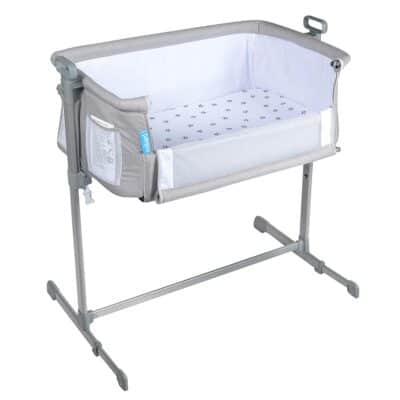
Editor’s Rating:
Quick Facts:
- Type: Bedside Bassinet
- Functionality: Foldable, Eight Storage Pockets
- Size: 41 Inches High x 35.5 Inches Long x 20.5 Inches Wide
While the Baby Delight Beside Me Bassinet is best for lower beds, the Milliard Side Sleeper is ideal for tall beds. It’s also easy to assemble, which is always appreciated by tired parents who do not want to deal with yet another complicated baby product.
This co-sleeper includes a waterproof mattress cover and fitted sheet, but we also recommend buying extra bassinet sheets to have on hand. Diapers leak and babies spit up, so you’ll inevitably need to change the sheet often. The waterproof mattress is made of plastic, though, and it’s hot because plastic doesn’t breathe. It also makes a lot of noise, which isn’t the best situation when you have a sleeping baby.
Safety
The Milliard Side Sleeper includes straps that attach it to your bed for added stability. The bassinet feet that extend under the parent bed also make it feel very sturdy.
Unlike the Baby Delight Beside Me Bassinet, this co-sleeper doesn’t have mesh sides. If your baby doesn’t move around in the bed at all, then this isn’t a concern. However, if your baby can scoot around at all, then it can be alarming to find your little one’s face pressed up against the fabric sides of this co-sleeper.
This isn’t a concern unique to this co-sleeper, though. You’ll encounter this same problem with stand-alone bassinets as well.
Functionality & Versatility
We really liked the number of storage pockets this co-sleeper has. Where most bedside co-sleepers have only one tiny pocket you can barely fit a pacifier into, this one has eight of various sizes. They’re perfect for storing supplies for middle-of-the-night diaper changes.
This co-sleeper also folds flat so you can easily travel with it or move it from room to room. With the fourth side reattached, it converts to a stand-alone bassinet. You can also rock it gently back and forth to soothe your baby back to sleep (theoretically).
Size
If you have your heart set on a bedside co-sleeper and you have a tall bed, then this is the co-sleeper for you. It accommodates beds all the way up to 31inches, and as most beds are around 25 inches tall, this should be high enough for even the plushest bed.
Like most co-sleepers, the Milliard Sleeper is meant for babies up to about four months old and with a twenty-pound weight limit.
Verdict
For very tall parent beds, the adjustable height of this co-sleeper works great. The additional baby storage provided by the eight pockets is a handy feature as well—who doesn’t love pockets? But the lack of mesh around the sides of the bassinet is a definite safety concern. Be sure not to use this co-sleeper after your baby starts being able to roll or scoot around in the bed.
Pros
- Accommodates the tallest parent beds
- Lots of storage pockets
- Easy assembly
- Includes a fitted sheet and waterproof mattress cover
Cons
- Lack of mesh sides can be a safety concern
- Plastic mattress cover is hot and makes a lot of noise
6. Best Budget Baby Co-Sleeper: Baby Delight Snuggle Nest
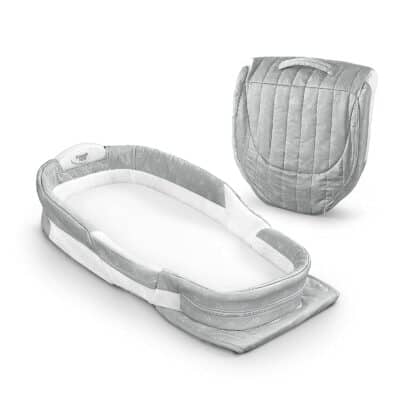
Editor’s Rating:
Quick Facts:
- Type: In-Bed Bassinet
- Functionality: Lightweight, Portable
- Size: 30 ½ Inches Long x 15 ½ Inches Wide x 6 Inches High
Baby stuff can add up quickly, but the Baby Delight Snuggle Nest is a good budget option. It’s very lightweight and portable, so it makes it easy for your baby to sleep in their familiar bed anywhere you go.
A fitted sheet is included, and the co-sleeper comes in a few different patterns so you can choose the one you think is cutest for your little one.
Safety
Although the sides aren’t entirely made of mesh, the bed does have a section of mesh all the way around. This not only keeps your baby cool, but the mesh is also at your baby’s level. In the event your baby gets pushed up against the side, they’ll still be able to breathe through the mesh.
This isn’t the sturdiest option, though. The sides are pretty soft, so they’re not meant to prevent parents who thrash around in their sleep from rolling over on the baby bed. The soft sides also lose their shape easily, which makes us think this isn’t the most durable co-sleeper.
Functionality & Versatility
Sometimes babies are only willing to sleep in one place, so the fact that this is so portable is a real advantage. It folds flat, and it only weighs a little over two pounds. You can easily carry it with you from room to room to lay your baby down where you can watch them sleep. The same goes for traveling or even just going over to a friend’s house—you can easily bring your baby’s bed along with you.
The Snuggle Nest also features a little night light so you can check on your baby at night. It’s especially helpful for middle-of-the-night diaper changes. When your baby outgrows the bed, it makes a great diaper changing pad.
Size
This co-sleeper is really small, though—at least as far as length. The maximum weight is 15 pounds, and it’s only 30 inches long, so there’s not much room for your baby to grow. You’re probably looking at only a couple of months of use. It’s still as wide as the SwaddleMe Sleeper, so it might be a tight fit for beds smaller than a king.
Verdict
The Baby Delight Snuggle Nest is a great budget option, but it’s best for small babies. Its overall flimsiness hurts its durability, so this isn’t the longest-lasting co-sleeper.
Pros
- Lightweight and portable
- Some mesh on the sides of the co-sleeper
- Includes a nightlight
- Includes a fitted sheet
Cons
- Babies will outgrow this co-sleeper quickly
- Takes up a lot of room in the bed
7. Best Baby Co-Sleeper for Outdoor Naps: Lulyboo Bassinet To-Go Infant Travel Bed
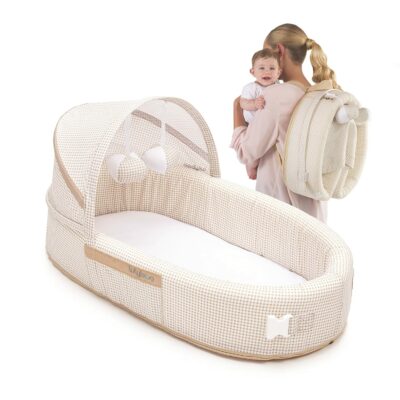
Editor’s Rating:
Quick Facts:
- Type: In-Bed Bassinet
- Functionality: Converts to a Backpack, Includes Lots of Extras, Waterproof Bottom
- Size: 32 Inches Long x 18 Inches Wide x16 Inches High (Including Canopy)
The Lulyboo Bassinet To-Go is perfect for parents who like to spend a lot of time outdoors with their babies. The waterproof bottom protects the bed from the elements, and it easily converts to a backpack. Take it with you camping, to the park, to the beach, or even out in your own yard.
The mattress cover it comes with is removable and washable so you can clean up quickly after a family camping trip.
Safety
If you use the Lulyboo Bassinet as a co-sleeper in your bed, the sides are high enough to keep your baby in their own space. The sides are also soft and flexible so they don’t become a potential hazard if your baby should get pressed up against them.
You should never carry your baby while in the bassinet as it’s not rigid enough to be safe. The sleeping pad is also plush instead of the firm mattress recommended for baby sleep safety.
Functionality & Versatility
This is probably the most versatile co-sleeper on the list. It has a lot of great included features, like loops for two soft toys, but you can also attach any baby toys. The DockATot has a toy arch that attaches to the lounger, but you have to buy it separately.
The Lulyboo Bassinet has a removable canopy so you can protect your baby from the wind and sun—perfect for naps outdoors. We like that it’s removable, too, so that you don’t have this big canopy taking up space in your bed if you use the Lulyboo as an in-bed co-sleeper.
It also has a storage pocket, and it’s actually a pretty good size for a small in-bed bassinet. It’s bigger than some of the pockets included on the larger bedside bassinets!
Size
The Lulyboo Bassinet is the biggest in-bed co-sleeper on our list, being longer and wider than both the SwaddleMe Sleeper and the Baby Delight Snuggle Nest. It also has a high weight limit of 30 pounds, so it can accommodate babies up to 12 months old.
However, this bassinet takes up a lot of room in your bed. If you and your partner try to sleep on either side of it, you’ll likely be hanging off the edge of the bed.
Verdict
If you spend a lot of time outdoors, or you’re about to go on a trip to the beach, then the Lulyboo Bassinet is a great buy. For everyday use, though, it’s a bit too flimsy. We’re not sure it would hold up and maintain its shape for long.
Pros
- Waterproof bottom
- Lots of included extras like a removable canopy and hanging toys
- Very lightweight and portable
- Folds up into a backpack to transport it easily
Cons
- Takes up most of the room in your bed
- Mattress pad is too soft for safe sleeping
- Feels a little flimsy
8. Widest Baby Co-Sleeper: Mamibaby Baby Lounger
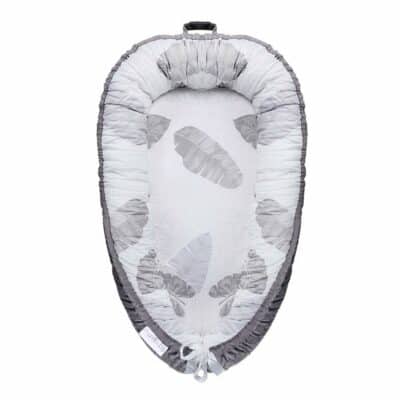
Editor’s Rating:
Quick Facts:
- Type: Lounger
- Functionality: Washable, Lightweight, Portable
- Size: 31.5 Inches Long x 19.7 Inches Wide x 4.92 Inches High
Really love the idea of the DockATot but disturbed at the price tag? The Mamibaby Portable Lounger is an excellent alternative, and the fabrics on it are actually softer. This lounger may not have the Carrara marble print like the DockATot, but it does have a few cute choices.
Safety
Babies love to be snuggled close like they were in the womb, so anything that recreates that feeling helps them sleep better. As mentioned before, baby loungers aren’t recommended by the AAP for co-sleeping. However, they make a great place for your baby to nap, and some babies will even accept a lounger over sleeping in your arms (though of course, they’d rather be with you!).
The Mamibaby Lounger has sides that cradle in close to your baby and prevents them from rolling out. The mattress is made of firm memory foam, so it creates a safe place for your baby to sleep.
Functionality & Versatility
The Mamibaby Lounger is entirely washable, and it has a hidden zipper to remove the cover. Putting it all back together can be tricky, though, because of the thick pads that make up the guardrails of the lounger. They can get out of shape easily, especially after washing.
The lounger is lightweight and portable, and it includes a carrying handle, which is a nice touch. It makes it just that much easier to take the co-sleeper around from room to room or for a visit to Grandma’s house.
The cover is reversible, so you can get even more use out of it between washes. Like the other loungers on our list, you can use the Mamibaby for tummy time or as a changing pad as well.
Size
This is the widest lounger on our list by an inch, so if you choose to use it in your bed, just know it’s going to take up a lot of room. It unites at the bottom to give bigger babies legroom, and although the product description says it can be used up to 12 months, we’re doubtful that a more active baby would be able to fit in this lounger. It becomes a safety hazard once your baby can roll, too, because they can get pressed up against the sides.
Verdict
This makes an inexpensive alternative to the DockATot, but the assembly after washing can be extremely frustrating. Be sure to keep the ribbon tied when it goes through the wash, or you’ll end up having to thread it through the lounger again.
Pros
- Inexpensive lounger
- Soft, washable fabrics
- Very lightweight and portable
Cons
- Difficult to reassemble after washing
- Cotton pad guardrails get bunched up easily
- Takes up a lot of room in your bed
9. Best Space-Saving Baby Co-Sleeper: Simmons Kids By the Bed City Sleeper
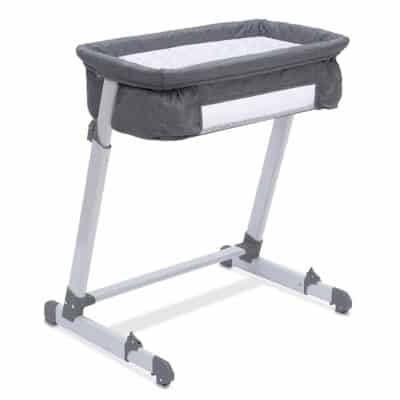
Editor’s Rating:
Quick Facts:
- Type: Bedside Bassinet
- Functionality: Stand-Alone Bassinet, Storage Pockets
- Size:5 Inches High x 31 Inches Long x 19.5 Inches Wide
If your room doesn’t have a lot of space for a bassinet, then the Simmons Kids By the Bed City Sleeper is a great option. It’s the slimmest bedside bassinet on our list, beating out the Milliard Side Sleeper by an inch.
Safety
It’s JPMA-certified for safety, which means the bassinet was independently tested to meet safety guidelines. Like the Mika Micky Bedside Sleeper, it has mesh along the longest sides of the bassinet so you can see your baby easily.
One safety concern for this bassinet, though, is the fact that it doesn’t stay level. This may cause your baby to roll toward one side or another, posing a suffocation risk. Use a leveler to be sure the bassinet isn’t leaning before putting your baby to sleep.
Functionality & Versatility
Unlike the other bedside co-sleepers on our list, this one doesn’t have a side that lowers so you can easily access your baby without getting out of bed. It’s basically a tall stand-alone bassinet that you can push next to your bed.
It has storage pockets on either end of the bassinet, which is always a helpful feature, but these are pretty small. The product description says you can store a pacifier in there, and well, that’s probably about it.
Although the extendable feet of the bassinet have wheels, they don’t slide easily. You’ll most likely end up having to pick it up to move it.
Size
The extended feet of the bassinet are height-adjustable, and the bassinet can fit beds up to 27 inches tall. The lowest setting is 22 inches from the floor, which puts the Simmons Sleeper at around the same height as the Mika Micky Bedside Sleeper. Unlike the Mika Micky, though, the small width and length of this bed mean your baby will likely outgrow it quickly.
Verdict
This is a great choice if you’re short on space in your room, but the small dimensions also mean your baby is likely to outgrow the Simmons Sleeper quickly. The Mika Micky is a longer-lasting choice if you have the space for it.
Pros
- Partially made of mesh on the sides of the bassinet
- JPMA-certified for safety
- Slim fit for bedrooms without a lot of space around the bed
Cons
- Side doesn’t lower so you can easily access your baby from your bed
- Doesn’t slide easily
- Doesn’t stay level
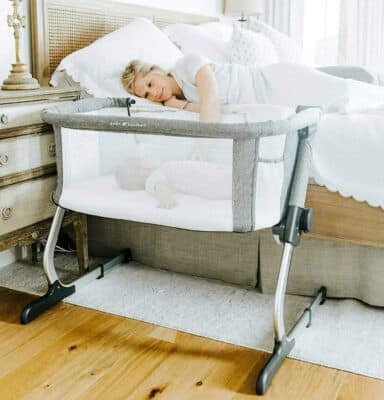
Editor’s Rating:
Quick Facts:
- Type: Bedside Bassinet
- Functionality: Foldable, Converts to Stand-Alone Bassinet
- Size: 37 Inches High x 22 ½ Inches Wide x 30.75 Inches Long
You know how most baby products are a huge headache to put together? Well, thankfully this isn’t the case with the Baby Delight Beside Me Bassinet. Everything about it from the assembly to adjusting the height is easy to do. It’s also a good choice if you have a low bed because it’s only 18 inches from the floor at the tallest setting.
Safety
This is the only bedside co-sleeper on our list with mesh on all four sides. As mentioned with the SwaddleMe Sleeper, having sides made of mesh decreases suffocation risks. It also makes it easier to see your baby and makes sure your baby is getting good airflow.
The Baby Delight Bassinet has straps to firmly attach it to your bed and give it more stability. Extendable feet that go under your bed along with the straps keep the bassinet stable and prevent it from tipping over.
Another great safety feature is that even when the panel is lowered and open to your bed, there are still a few inches of a barrier to prevent your baby from falling out.
Functionality & Versatility
Although the Baby Delight Bassinet is a fairly no-frills model, it does convert to a stand-alone bassinet just by zipping up the fourth side panel. There’s also a small storage pocket, but don’t expect to be able to store much more than a diaper or two.
It’s lightweight and folds flat, so it’s easy to move it from room to room or bring it with you while traveling. You can glide it from side to side to soothe your baby, but this feature also ends up making the whole bassinet feel wobbly and unstable.
Size
If you’re looking for a tall bedside bassinet, then this isn’t the best option. You’d be better off with the Milliard Side Sleeper. The Baby Delight Bassinet is ideal for shorter beds as it’s 13 inches from the floor in its lowest setting. It can be adjusted to six different heights, with the highest being 18 inches from the floor.
This co-sleeper is also the most compact bedside option on our list. The guidelines say babies up to five months old can sleep in this bed, but with a length of only 30.75 inches, your baby may outgrow it faster than that. On the other hand, if you have limited space in your room, then this is the ideal bedside co-sleeper.
Verdict
For parents with a low bed, this is a great bedside co-sleeper option. We think the mesh sides also make this bassinet one of the safest on the list. However, it doesn’t work well if you have a tall bed or want a co-sleeper with all the bells and whistles. Got an adorable, chunky baby? You might want to look at co-sleeper options that will last longer like the Mika Micky Bedside Sleeper.
Pros
- Mesh sides
- Includes a waterproof fitted sheet
- Straps secure the bassinet to the parent bed
- Easy to assemble and adjust the bassinet
- Folds flat
Cons
- May not be tall enough for high parent beds
- Expensive without offering parents a lot of extras
Still feeling overwhelmed by all the different co-sleeper choices? We’re here to help! Read on for a comprehensive buying guide with everything you wanted to know about baby co-sleepers.
Complete Guide to Buying the Best Baby Co-Sleepers for 2025
Sleep is serious business for babies, especially since they spend so much time doing it. As a parent, you want to find a bed that your baby will get the most rest in but also one that’s safe. Here, we’ll answer all your questions about baby co-sleepers so you can be confident in your choice.
Types of Co-Sleepers
It can be hard to decide which type of co-sleeper is best for your family, but we’ve broken down the three types to help you figure out the best option based on safety, functionality, versatility, and size.
In-Bed Bassinet
This type of co-sleeper is ideal for being close enough to your baby during the night to lay a hand on their chest. It’s a good choice for breastfeeding and/or C-section moms because they don’t have to lift their babies very high to snuggle their babies close for feeding.
These bassinets take up a lot of room in your bed, though. For smaller parent beds, these aren’t the best option because then you and your partner will be hanging onto the edge. Not the most comfortable situation!
As much room as in-bed bassinets take up in your bed, your baby will still outgrow them quickly. Your baby will most likely get the most use out of the bassinet for the first few months. After that, your baby will probably be too big and active to be comfortable anymore.
If you’re considering an in-bed bassinet, ask yourself:
- Is my bed big enough for this type of co-sleeper?
- Do my partner and I not toss and turn all night, instead staying in one place?
- Do I like the idea of being close enough to lay a hand on my baby all night?
- Will this help me breastfeed?
- Will this help my C-section incision heal?
- Do I prefer a more inexpensive co-sleeper?
- Will my baby be able to sleep in this type of bed safely? (Read more about co-sleeper safety under Are Co-Sleepers Safe for Babies?)
If you answered yes to most of these questions, then an in-bed bassinet might be the right choice for you. Our favorite is the SwaddleMe Sleeper.
Just for easy reference, here are the dimensions for the four most common bed sizes:
- Full: 54 inches wide by 75 inches long
- Queen: 60 inches wide by 80 inches long
- King: 76 inches wide by 80 inches long
- California King: 72 inches wide by 84 inches long
Pro tip: If you plan on buying a bedside bassinet, then be sure to measure the height of your bed as well.
Bedside Bassinet
This type of co-sleeper is the one recommended by the AAP because your baby has their own safe sleeping space. Typically, these bassinets are the same height as your bed and have one side open so you can reach your baby easily. Like most co-sleepers, though, your baby will quickly outgrow the height and weight limits. If you’re tight on space in your room, or on the sides of your bed, then this type of co-sleeper can be cumbersome, too.
If you’re considering a bedside bassinet, ask yourself:
- Do I want to follow the AAP’s recommendations for their preferred co-sleeper type?
- Do I want my own space in my bed but be able to easily reach and see my baby at all times?
- Do I want to be able to easily pull my baby into bed with me for breastfeeding?
- Is it important to me that my baby easily transitions to a crib later on?
- Do I have enough space on either side of my bed for a bedside bassinet?
If you answered yes to most of these questions, then a bedside bassinet might be the right choice for you. Our favorite is the Mika Micky Bedside Sleeper.
To help you decide which bedside co-sleeper will fit your bed best, here is a quick comparison of the different measurements for each:
Overall dimensions: 32.7 inches high x 36 inches long x 24.5 inches wide
Maximum bed height: 28 inches
Lowest bed height: 18 inches
Baby Delight Beside Me Bassinet
Overall dimensions: 37 inches high x 30.75 inches long x 22.5 inches wide
Max bed height: 18 inches
Lowest bed height: 13 inches
Overall dimensions: 41 inches high x 35.5 inches long x 20.5 inches wide
Max bed height: 31 inches
Lowest bed height: 23 inches
Overall dimensions: 41.5 inches high x 31 inches long x 19.5 inches wide
Max bed height: 27 inches
Lowest bed height: 22 inches
Lounger
Lounger co-sleepers are basically expensive pillows for babies to lie on. The sides are plush and made to snug in close to your baby to mimic being in the womb again. Like swaddling, most babies find this very soothing.
Loungers are lightweight and portable, so you can bring them along with your baby from room to room easily. They’re washable, too, which is always a plus when it comes to the various fluids that will inevitably be deposited on them from your sweet little pooping machine. Loungers are also versatile in that you can use them to hold your baby while you get some work done nearby.
Babies typically outgrow this type of bed quickly, though, so it isn’t a good option beyond the first few months. Loungers are also not recommended by the AAP as one of the safe co-sleepers for sleeping, so keep that in mind when you’re weighing your options.
If you’re considering a lounger type, ask yourself:
- Do I plan to use this for in-bed co-sleeping while both my partner and I are asleep?
- Will I get a lot of use out of this lounger in supervised naps, tummy time, lounging on the couch, etc?
- Is it important to me to follow the AAP’s recommendations on preferred co-sleeper types?
- Do I want to be able to easily wash my baby’s bed?
- Do I want to be able to take my baby’s bed with me wherever we go?
It really comes down to safe sleeping and what you’re comfortable with when you consider a lounger type as an in-bed co-sleeper. If you’ve decided a lounger would make your life easier and your baby happier, then our favorite is the Snuggle Me Lounger.
Co-sleeping is a big decision for your family, so naturally, you have questions. But luckily, we have the answers!
What Does Co-Sleeping With a Baby Mean?
The terms “co-sleeping” and “bed-sharing” are typically used interchangeably, but they have two different meanings. The simplest definition of co-sleeping with a baby is when a parent shares their sleeping space in some way with their baby. Bed-sharing, on the other hand, refers to sleeping with your baby in your arms in your bed. The baby co-sleepers in this article are generally safe because your baby will be sleeping in their own space, just close to you.
So while co-sleeping hasn’t been found to increase the risk of SIDS, bed-sharing has, but under certain circumstances—like the parents being heavy drinkers, the baby getting covered by a thick blanket, or the baby being premature.
What’s the Difference Between a Co-Sleeper and a Bassinet?
Confused about all these baby terms that are sometimes used interchangeably? We don’t blame you. It’s confusing because co-sleepers and bassinets are similar, but not the same.
A co-sleeper can be a type of bassinet, but a bassinet isn’t necessarily a co-sleeper. A bassinet—rather than a co-sleeper bassinet—is a small baby bed made to stand on its own in a room. Co-sleepers, on the other hand, are made to be connected to your bed somehow. They might be made to be placed on top of the parent bed (like the SwaddleMe Sleeper or the Snuggle Me Lounger), or they might be made to be open on one side to the parent bed (like the Mika Micky Bedside Sleeper).
Are Co-Sleepers Safe for Babies?
This is the biggest question—the one that’s no doubt on your mind while you search for the best co-sleeper for your baby. As mentioned before, co-sleeping tends to be a controversial topic, although it’s good to know that many other cultures sleep with their babies. In most Asian countries, for example, the cultural norm is for parents to keep their baby in the room with them. Many also bed share.
When it comes to the professionals here in the United States, the American Academy of Pediatrics (AAP) recommends keeping your baby in your room with you, at least for the first six months and ideally for the first year. When it comes to co-sleeping, the co-sleeper of choice for the AAP is a bedside bassinet.
As for in-bed bassinets, the AAP doesn’t recommend for or against them since not enough research has been done on their safety. However, if you follow the safety guidelines for best sleep practices for your little one, then they are arguably as safe as a stand-alone bassinet.
There are also many things you can do to make sure you’re making your baby’s bed the safest it can be. These are the AAP’s safe sleeping guidelines that reduce the risk of suffocation and SIDS:
- Don’t sleep with your baby in your bed if you or your partner are heavy sleepers, smoke in the bedroom, take medication that makes you sleepy, or drink alcohol to the point of intoxication.
- Make sure your baby’s sleep surface is flat and rigid. People complain about baby’s mattresses being thin and hard, but they’re supposed to be like that!
- Don’t put your baby in an in-bed bassinet or lounger if you have a waterbed or super plush mattress and bedding.
- Make sure your baby’s bed is free of loose blankets, toys, or crib bumpers.
- If you use an in-bed bassinet or lounger, make sure your own blankets and bedding aren’t covering up your baby. You can use a separate blanket from your partner to keep from accidentally pulling the bedding up over the baby bed.
Like everything else in parenting, it’ll be up to you to decide what’s best for your baby but following these safe sleeping guidelines will help ensure your baby is safe—even in a co-sleeper.
What’s the Safest Type of Co-Sleeper?
If you’re going by the AAP recommendations, then the safest type of co-sleeper is the bedside bassinet like the Mika Micky Bedside Sleeper or the Baby Delight Beside Me Bassinet. That’s because bassinets are considered safe beds for babies, and a bedside bassinet is basically just one that’s been shoved close to a parent bed.
Going by the same recommendations, a lounger type like the Snuggle Me Lounger is probably the least safe because of the plush sides. The AAP also doesn’t seem keen on putting a baby in any type of bed that sits on top of the parents’ bed, such as the SwaddleMe Sleeper, but that doesn’t mean these bassinets and loungers are unsafe in every situation. Following the manufacturer’s guidelines and only using loungers while a baby fits the weight limit and isn’t able to roll over is a good way to ensure safe sleep.
Is a Co-Sleeper Worth It?
As parents, we’d do just about anything to get a little more sleep when we have a newborn, and that’s the appeal of a co-sleeper. But are they really worth it?
We think so! If you’re on the fence, though, here are some pros and cons:
Pros:
- Your baby will be close by for night feedings—if you’re breastfeeding, you won’t even have to get up!
- You can quickly and easily check on your baby just by turning your head.
- Babies need to hear their moms nearby. It helps with their breathing and heart rate. (See What Are the Benefits of Co-Sleeping?)
- Your baby will sleep better with you close enough for your baby to smell you and hear you breathing.
Cons:
- Co-sleepers can be expensive for a bed that gets only a few months of use.
- Limited use. Your baby will outgrow their co-sleeper quickly.
This last con brings us to our next concern:
How Long Can a Baby Stay in a Co-Sleeper?
Generally, co-sleepers and bassinets are made for a baby’s first few months. Once they become active—rolling over, trying to push up on their hands and knees—it’s time to move them to a crib. There are also height and weight limits for co-sleepers. These are usually somewhere around 20 pounds and 25-30 inches. Depending on how fast your little one grows, that could be around three or four months. The Mika Micky Bedside Sleeper, though, accommodates babies up to 33 pounds, so you might get a few more months of use out of that co-sleeper.
What Are the Benefits of Co-Sleeping?
If you’re like us, you want to know that what you’re doing is beneficial to your baby, and that includes co-sleeping. When we did some research, we found an anthropologist named Dr. James McKenna who is Director Emeritus of the Mother-Baby Behavioral Sleep Laboratory of the University of Notre Dame. He has written over 150 articles on co-sleeping and also has a published book on the subject.
He lists numerous advantages to co-sleeping with your baby:
- It helps your baby breathe better, regulate their temperature better, and even boosts their immune system.
- Your baby will go to sleep faster and stay asleep longer.
- Your baby will get more sleep this way.
- Moms who co-sleep report feeling better rested.
- If you’re breastfeeding, it makes night feedings easier because you can just pull the baby into bed with you.
- It may even help your baby to have a stronger emotional relationship with you and your partner.
Final Thoughts on Co-Sleeping
If you follow safe-sleep guidelines, then co-sleeping with your baby is beneficial for both of you, no matter the co-sleeper you choose. Co-sleeping is the best way for everyone to get more sleep—and what parent couldn’t use more sleep?—while also providing a lot of health benefits for your baby.
We hope our reviews and buying guide help you decide which type of co-sleeper will work best for your little one. Just remember that there’s nothing more important than your baby staying safe—even while they sleep.
Here’s to better sleep for you and your baby!
